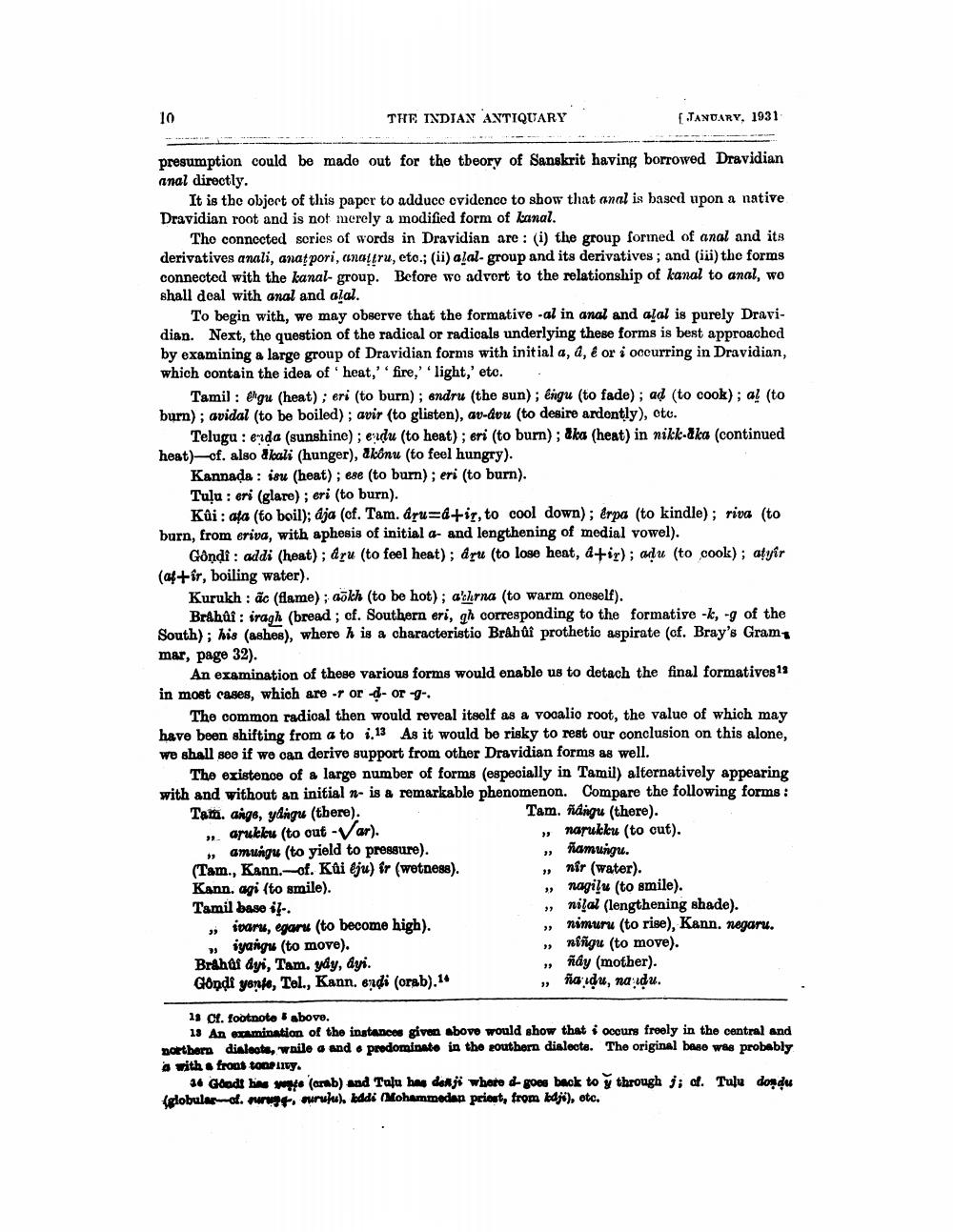________________
10
THE INDIAN ANTIQUARY
JANUARY, 1931
presumption could be made out for the theory of Sanskrit having borrowed Dravidian anal directly.
It is the object of this paper to adduce evidence to show that anal is based upon a native Dravidian root and is not merely a modified form of kanal.
The connected series of words in Dravidian are: (i) the group forined of anal and its derivatives anali, anat pori, analiru, eto.; (ii) alal- group and its derivatives, and (iii) the forms connected with the kanal- group. Before wo advort to the relationship of kanal to anal, wo shall deal with anal and alal.
To begin with, we may observe that the formative -al in anal and alal is purely Dravidian. Next, the question of the radical or radicals underlying these forms is best approached by examining a large group of Dravidian forms with initial a, a, é or i occurring in Dravidian, which contain the idea of heat,'' fire, light,' etc.
Tamil : egu (heat); eri (to burn); endru (the sun); éigu (to fade); ad (to cook); a! (to burn); avidal (to be boiled); avir (to glisten), av-dvu (to desire ardently), otu.
Telugu: enda (sunshine); edu (to heat); eri (to burn); dka (heat) in nikk-dka (continued heath-of. also dlali (hunger), akónu (to feel hungry).
Kannada : isu (heat); ese (to burn); eri (to burn). Tulu : eri (glare) ; eri (to burn).
Kûi : afa (to boil); ája (cf. Tam. dyu=a+ir, to cool down); ērpa (to kindle); riva (to burn, from eriva, with aphesis of initial - and lengthening of medial vowel).
Gôndi: addi (heat); dru (to feel heat); aru (to lose heat, 2+ir); adu (to cook); atyîr (at+ir, boiling water).
Kurukh : c (flame); Gökh (to be hot); a'chrna (to warm oneself).
Brahui : iragh (bread; of. Southern eri, gh corresponding to the formativo -k, -, of the South); his (ashes), where h is a characteristio Brahûf prothetic aspirate (cf. Bray's Gram mar, page 32).
An examination of these various forms would enable us to detach the final formatives 13 in most cases, which are -t or - org.
The common radical then would reveal itself as a vocalio root, the value of which may have been shifting from a to i 13 As it would be risky to rest our conclusion on this alone, we shall see if we can derive support from other Dravidian forms as well.
The existence of a large number of forms (especially in Tamil) alternatively appearing with and without an initial n-is a remarkable phenomenon. Compare the following forms: Tam. angs, yangu (there);
Tam, fiangu (there). ». aruklu (to cut -Var).
» nasulku (to cut). amungu (to yield to pressure).
Ȗamungu. (Tam., Kann.-of. Kui eju) fr (wetness).
» nir (water). Kann, agi (to smile).
» nagilu (to smile). Tamil base it..
» nilal (lengthening shade). » ivaru, egaru (to become high).
» nimuru (to rise), Kann, negaru. » iyangu (to move).
» niñgu (to move). Brahui dyi, Tam, yay, dyi.
%ây (mother). Gondi yonte, Tel., Kann, endi (orab). 14
Ȗadu, na du.
13 Cf. footnote above.
13 An examination of the instances given above would show that i occurs freely in the central and portbers dialoota, while a and predominato in the southern dialecte. The original beso was probably A with a front tone liv.
** Goodt hoe w e (arab) and Talu has dok ji where goes back to y through ji of. Talu don du (globularo purwyr suruhu), kddi (Mohammedan priout, from bdjo), etc.




